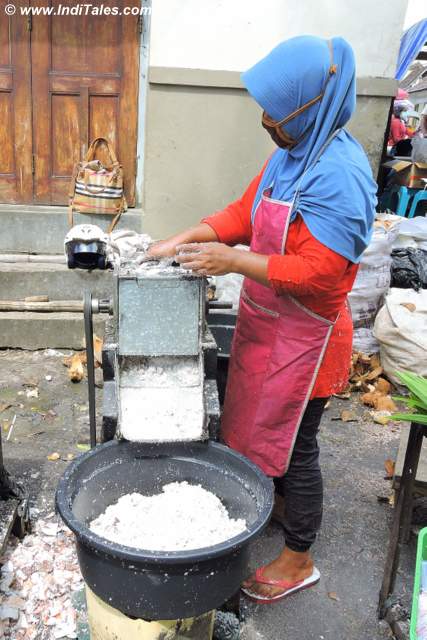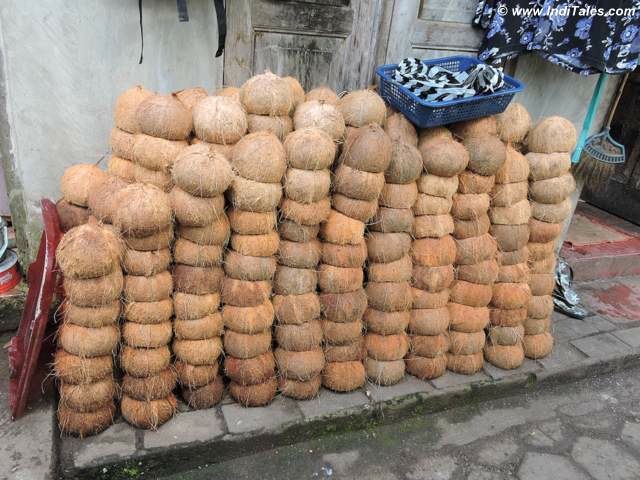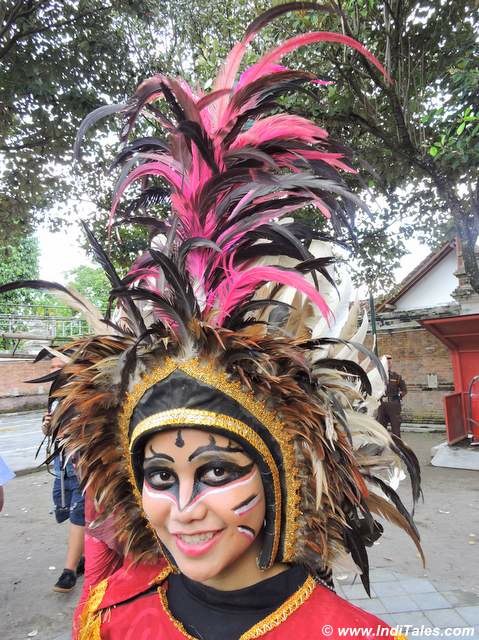Kota Gede or Kotagede is for heritage hunters like me. It is for people, who like me like to get lost in narrow lanes of the past. It is for people who love heritage that exists in a common man’s house and its surroundings. If you like walking around the old town in the oldest living quarters of a city, come along. Let me take you for a walk through the heritage area and the traditional market.

Where is Kota Gede? Well, it is a suburb of Yogyakarta in Central Java, Indonesia. It is about 5 km from Yogyakarta. You can take a taxi, bus, or horse carriage to reach the place from Yogyakarta.
What is Kota Gede?

Kota Gede literally means the big city or a great city. It is the oldest living neighborhood of Yogyakarta. It was once the capital of Mataram Kings way back in the late 16th CE. I, however, see it more as a place where wealthy merchants lived. They built houses with thick walls to take care of their abundant wealth.
Today, it is home to silversmiths. Go there to do your silver shopping or just to see how finely carved silverware is made.
What to do in Kota Gede, Yogyakarta

Narrow lanes reminded me of Pols of Ahmedabad. These lanes also fit into each other like a jigsaw puzzle connecting small sub-neighborhoods. There are small gated communities of few houses with very interesting security arrangements. The exteriors of the houses have intricately carved wooden panels or brackets in both places.
You can find Hindu, Muslim & Christian houses here. I loved the way our guide showed us how to identify the houses. All houses have wood carvings on their doors and windows. A Hindu house has a lotus carved, a Muslim house has calligraphy, and Christian ones have a crown carved. Sometimes you have to make an effort to decipher, but more often than not, you would find those symbols.
Visit Pasar Gede on Pasar Legi
Pasar Gede meaning the great market is the traditional market square of Kota Gede. Pasar Legi means the market day. It is best explored on the Pasar Legi, which is regular but not every day.

Any small town or maybe even bigger ones revolve around a market. A traditional market sits at the heart of the town as well. We took a walk around this market that does not seem very different from our own markets. But each market must have something that makes it distinct.
So, this is what I found at Pasar Gede market. Like most local markets in Asia, this is also primarily run by women. Most stalls have a woman behind them.

A coconut grating machine – how our South Indian women would love it.

At another place, I saw these coconut shells neatly arranged. Now, you know that Indonesians eat a lot of coconuts.

The fish market was quite like the fish market in Goa, but what was different was the neatly packed ready-to-pick packaging of the fish. Some of the fish seems marinated but as a vegetarian can’t say much about it.

Tofu is what I get to eat all the time in South East Asia, but this is the first time I saw how it is sold in the local markets. In a pile in the bamboo baskets.
Walking around the Jagalan Heritage area
This is the heritage area. Lined by Kalang Houses – a combination of the traditional wooden Javanese houses with brick Dutch architecture.

Old city walls can still be seen in the Jagalan Heritage area.
Located close to Merapi Volcano, most areas in Java are prone to volcanic eruptions and earthquakes. You can see the impact of earthquakes on houses here. Some empty houses will tell the story of who decided to move after such mishaps.

Walking around we saw many beautiful carved doors.

An interesting part was Alun-Alun village where there are 10 or so interconnected houses and they are located between two gates. Lately, this lane has come to be known as “Between Two Gates”. There was a huge wooden horn like a bell and a stick hanging outside a house. I conveniently thought this was a doorbell. And yes, I was wrong for people in this kind of community hardly need a doorbell. This is a security stick – if someone senses a danger, to inform the community of the same. In simple words, it helped to keep the thieves away. Simple & Creative – I must say.

It is difficult to put into words how it feels to walk in those narrow lanes. It is like sleepwalking in another era.
Street Art

I believe street art is a recent phenomenon. It is like the current day trend around the world.

Just a glimpse of the street art in this area.
Ndondongan Area

This is the only area where you see a well-preserved heritage building – the royal tombs & a mosque. It is a brick structure with connected compounds.

The day we were here, there was a local festival going on. We saw artists sitting & painting. Children with painted faces danced around as the sponsors Air Asia distributed hand fans to everyone.

It was a pleasure to be a part of the local celebration.
Art, Craft, Food
Kota Gede Silver Jewellery
I could not meet a silversmith but I received this lovely silver brooch. Does it not remind you of filigree work from Odisha?
Well, Java and Odisha had trade links in ancient times. We would never know which one of them developed this skill & which one of them adopted it. Or could it have been a joint effort?
Batik – DIY

Batik printing using the traditional wax method can be found across South East Asia. Here you can try your hands at Batik, as we did.

Trace the design on a piece of cloth with wax, and then dip it in the color before putting it in the hot water to remove the wax.
Jamu Tasting
Jamu is nothing but a drink made from various herbs and fruits. I tried the one with lime, honey & ginger – it was refreshing, especially after all the walking we did.
As Indians, we are familiar with most of the tastes, but some of the combinations were new. The lady explained the advantages of each of the drinks – like this cleans your skin, this cleans your stomach, this is good for digestion, etc.
How to reach Kota Gede?

- You can always take a taxi or bus.
- However, I suggest you take a ride on Becak – it is a twisted version of our very own cycle rickshaw.
- Or, try riding an Andong – a horse-drawn carriage – a quirky mix of our desi tonga & and a Victorian carriage. The colorful carriages are picture-perfect & would make you feel you are traveling back in time.
- If you want to stay with modern transportation, you can still have the quirkiness of Jogja, try the glittering Tuk Tuks or Auto Rickshaws. Remember, they look their best after sunset.
I loved walking around and would recommend it to anyone.
Recommend you read the following travel blog on places to visit in wonderful Indonesia.
Visiting Wonderful Indonesia – First Impressions
Borobudur Temple – Heritage Jewel of Indonesia














The life is so cultures. Happy to know that they are they are still maintaining it. Will like to visit their one day.
True Harish – life is culture. Do visit Kota Gede some time.
What a gorgeous city! and batik? Here?
Yes, they make Batik here too…
It was good to know about such a place. Maybe in India we have many such similar ancient heritage villages. If only our tourist department did something to develop and promote these.
Durga, there are many such old quarters in India. I have written about a lot of them from Delhi & Hyderabad. Yes, tourism ministry can do something about promoting it, but so can we, by visiting them & by sharing pictures of them so that others go.
This looks to be a beautiful place. Awesome pictures and it seems you had a great time.
Oh, it was lovely and you know I have a fascination for old living spaces. I have to go back to Yogyakarta & Bali.
Great story and beautiful photos.
Where did you find the guide who showed you around?
Tatjana, We were guided by the friends and local Indonesian bloggers. They showed us Indonesia in a very personal way – can never thank them enough.